Getting to grips with clover management - learnings from Moorepark
Tuesday, 18 July 2023
Forage For Knowledge contributor case study: Phil Asbury at Clive Hall Farm.
Phil holds the tenancy to Clive Hall Farm in Cheshire and has been contract farming with Grasslands Farming since 2007. There are 210 Kiwi Friesian spring block calving cows on 63 ha of grazing platform with 33 ha of rented support ground. Cows are currently yielding on average 21 litres with 5.5% fat and 3.4% protein. Average farm cover is 2,358 kg DM/ha with a grass growth of 63 kg DM/ha this week.
When I spoke to Phil this week (mid-July 2023), he was hoping to take around 50 ha of second cut the following day. The first cut taken on 25 May was later than he had hoped and although there was good bulk it was lower quality than he had hoped.
Some silage was also taken from the platform which, with hindsight, made them tight on grazing in the dry weather, meaning the clamp had to be opened for a couple of weeks but with the more recent rain they are back on track.
Learnings from Moorepark
Phil recently attended the Moorepark Open Day and there were differing views compared with previous advice regarding management of clover and nitrogen use.
Since 2017, reseeds have included clover (usually a mix of two diploid and one tetraploid perennial ryegrass and clover) with the aim to be reducing artificial nitrogen to the point of very little or even none, but Phil is trialling a change following the open day.
Previously clover has only been receiving 25 kg N in spring when conditions allow plus a couple of rounds of slurry, but Phil has noticed that although the paddocks have performed well it looks like they have been limited, so he will now be applying up to 75–100 kg of total N (fertiliser and slurry) early season and then low applications later in the summer.
Phil will also be trying to gauge when his clover is fixing nitrogen (potentially not until 12–18 months) by checking nodule colour (brown - fixing N; white - not).
This May, Phil had some of his best success with clover establishment over 5 ha. Cows grazed well down a day or two before and then clover was direct drilled at a rate of 5 kg/ha. The clover germinated well at first then shrivelled with the hot weather, but has rejuvenated well with the recent rain and the paddocks have been grazed three or four times since.
Paddocks to overseed with clover are chosen if they have the correct soil indices and pH and if there is low weed burden. Paddocks with clover are only spot-sprayed for weeds.
The talks at Moorepark also highlighted to Phil about the care needed for clover persistency. At Clive Hall Farm mid-way through calving there is pressure on the housing and cows sometimes must graze in suboptimal conditions.
The poaching this year has put pressure on growth later in the season as root structure has been damaged and there is less ability to maintain water.
Going forward Phil will be trying to limit this by using stricter on/off grazing and avoid the more sensitive clover paddocks as much as possible.


